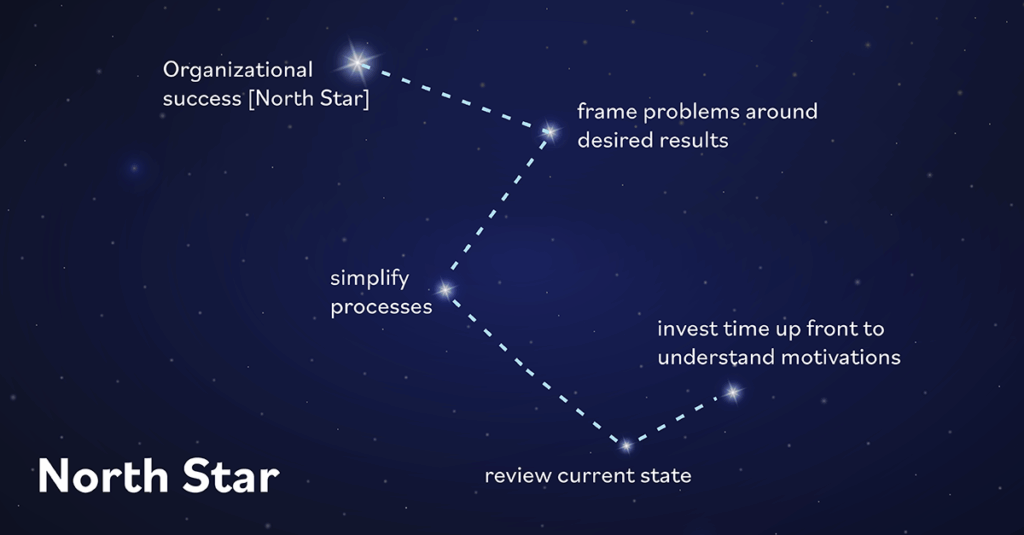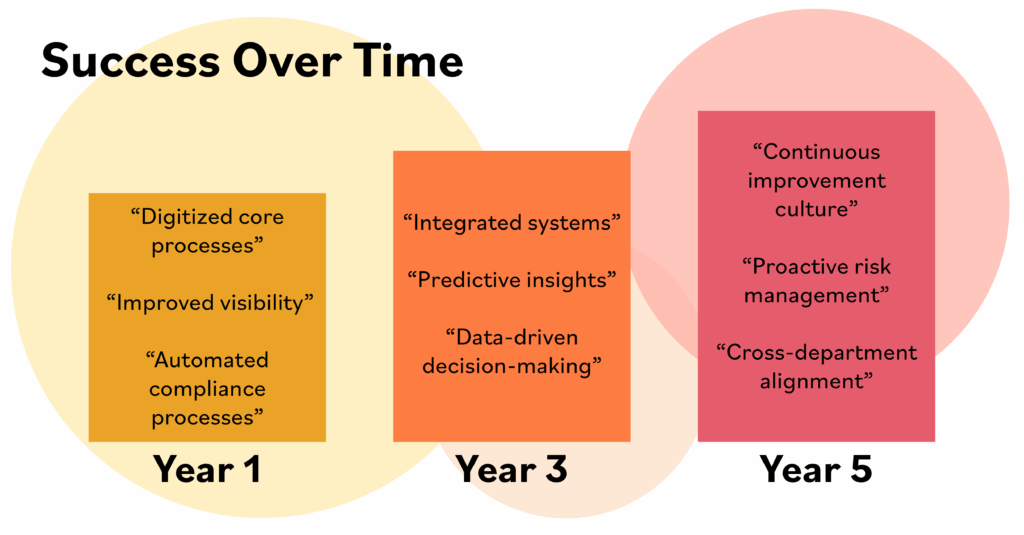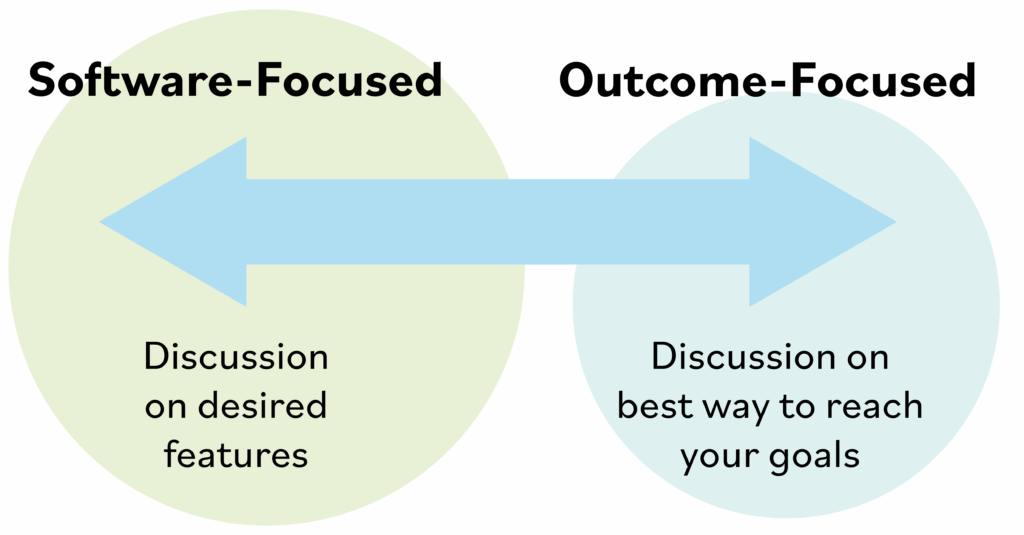Preparing to Look for EHS Technology: Four Keys to a Successful Evaluation Process
November 19, 2025
6 minute read

Throughout my career, I’ve seen many EHS technology evaluations. Some go wildly successful, others painfully convoluted. I started my career as an EHS practitioner, helping organizations research, evaluate, select, and implement new technologies.
For the last five years, I’ve worked on the vendor side, using my experience to show organizations how our solutions can solve their key problems. Seeing both sides has made it clear what makes some technology evaluations succeed while others struggle.
The difference isn’t about finding the perfect software or the vendor with the most features. Success hinges on the preparation done before talking to vendors or scheduling demos.
When organizations complete four important steps first, they shift the conversation from features to solving real business problems.
The hidden cost of rushing to market
Many organizations start evaluating vendors before they are fully prepared. They schedule demos, create lengthy RFPs and evaluate features without first understanding their fundamental needs.
This approach leads to several predictable failures:
- implementations that don’t address core problems
- low user adoption rates, and
- technology that becomes expensive shelfware.
The organizations that succeed take a different path. They:
- invest time up front to understand their motivations
- review their current state
- simplify their processes, and
- frame their problems around the results they want.
This preparation acts as a north star throughout the evaluation process, keeping everyone focused on what’s important.

Understanding your why
Simon Sinek’s famous quote, “when we know WHY we do what we do, everything falls into place,” is especially relevant when starting a technology journey. Yet, when I first meet with organizations and ask “what does success look like for your organization?” many struggle to answer.
Often, this is because they have not had the internal discussions to understand why they are looking for a technology solution. If they have, the reasons are usually surface-level, like, “everything is on paper today”, “we use Excel”, or “data is siloed”.
These observations are valid starting points, but they’re symptoms, not root causes.
Just like conducting a 5-why analysis during an incident investigation, we need to dig deeper. If “everything is on paper” is the issue, why does that matter? What results are being blocked? What would improve if this changed?
Thinking about what success looks like in 1 year, 3 years, and 5 years, helps bring more clarity. This exercise forces organizations to think beyond immediate pain points and consider their strategic safety vision.
When you know your “why,” every conversation stays focused on addressing core organizational needs rather than getting distracted by features.

Mapping current vs. desired states
Once you’ve defined your initial “why”, it’s important to validate them with people across the organization. This means talking to people both vertically (from EHS executives to frontline workers) and horizontally (across EHS, IT, Operations, and other departments). Each stakeholder group brings unique perspectives that can uncover additional “whys” or refine your understanding of existing ones.
Related article: The Internal Champion’s Playbook: How to Build Executive Buy-In for EHSQ Software
I recently advised an EHS Director to spend time talking with frontline workers before finalizing their technology requirements. He assumed their biggest challenge was getting worker engagement in observation programs.
But, employees said submitting observations was straightforward. Their real frustration was accessing Job Safety Analyses (JSAs) at the point of work. Their “why” for technology was immediate access to work procedures for unfamiliar or infrequently performed tasks. This discovery shifted the evaluation criteria. Without this stakeholder validation, they would have solved the wrong problem for the frontline.
Spend time talking with people across the organization to validate your “whys”. Document what’s working and where they feel there’s room for improvement. Tie these pain points to your organizational “whys”. Create a clear map linking current state problems to desired future outcomes.
Starting the de-cluttering process
Most organizations accumulate tremendous process debt over time. It’s common to find EHS management systems with 50, 100, or even 300 or more forms and workflows. Many were made for specific situations that no longer exist, outdated compliance requirements, or well-intentioned initiatives that never gained traction.
Implementing new technology presents a unique opportunity to review and simplify your EHS management system. With your validated “whys” and current state understanding, you can strategically remove unnecessary steps and focus on what matters most.
Assemble a cross-functional team to sort your business processes into three buckets:
- Must-Have: Directly supports organizational “whys” or compliance requirements
- Nice-to-Have: Provides value but isn’t critical to core outcomes
- Not-Needed: Outdated, redundant, or low-value processes
Next, look at workflows associated with Must-Have processes. Can they be simplified? Are approval steps adding value or just time? Many organizations find their workflows evolved to work around system limitations rather than optimize outcomes. New technology should enable process improvement, not perpetuate inefficiencies.
Remember: technology is a tool that amplifies what it’s applied to. Applied to streamlined, value-focused processes, it accelerates success. Applied to broken or bloated processes, it digitizes dysfunction.
Drafting outcome-focused problem statements
The last step is to write down what you’ve learned in a way that helps you talk to vendors. Many organizations make lists of features they want, but this can limit new ideas. Instead, write problem statements on the results you want, so vendors can suggest creative solutions.
Here are two different ways to approach this:
- Solution-Focused: “Does your software include automated email alerts with SMS backup, escalation workflows, and integration with Microsoft Teams?”
- Outcome-Focused: “EHS Managers need immediate awareness of safety incidents at their responsible locations to ensure nothing falls through the cracks and to improve reporting, investigation, and claims management turnaround times.

The outcome-focused statement invites discussion about different ways to reach your goal. By focusing on outcomes rather than prescribed solutions, you let vendors use their expertise and innovation to help solve your most important problems
Putting it all together: Your technology evaluation roadmap
When you complete these four steps — understanding your why, mapping your current state, de-cluttering, and drafting outcome-focused problem statements — before talking to vendors, the whole evaluation process changes. Instead of comparing features comparisons, demonstrations and discussions become problem-solving sessions. Vendors can tailor their presentations to your specific needs rather than running through generic capabilities.
This preparation also speeds decision-making. With clear criteria based on your goals, comparing vendors becomes more objective. You can see how well each solution fits your core whys, instead of getting lost in feature lists.
This groundwork also makes implementation much more successful. Vendors understand your priorities from day one. Configuration focuses on your must-have processes. Change management efforts can clearly articulate the “why” behind the transformation, improving user adoption.
Related article: The Role of IT in Successful EHSQ Software Deployments

The path forward
Choosing new technology doesn’t have to feel overwhelming.
By spending time on these four steps, you turn a usually confusing process into a clear, strategic project with set goals and ways to measure success.
It’s not about finding perfect software, it’s about finding the right solution and partner to help solve your organization’s specific challenges and achieve your goals.
Related article: How to Show Finance the Value of EHS Tech Using Soft ROI






